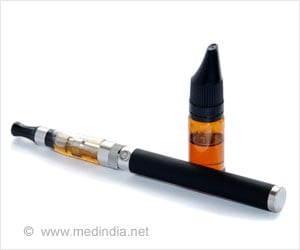Chronic use of JUUL electronic cigarette products can lead to cellular damage. E-cigarettes deliver nicotine, a highly addictive stimulant that has the potential to affect the still-developing adolescent brain.

TOP INSIGHT
Higher concentration of nicotine in JUUL electronic cigarette products can lead to cellular damage.
Read More..
"The nicotine concentrations are sufficiently high to be cytotoxic, or toxic to living cells, when tested in vitro with cultured respiratory system cells," said Talbot, the director of the UCR Stem Cell Center. "JUUL is the only electronic cigarette product we found with nicotine concentrations high enough to be toxic in standard cytotoxicity tests. A big concern is that its use will addict a new generation of adolescents to nicotine."
JUUL e-cigarettes are made by JUUL Labs, an electronic cigarette company. JUUL use is widespread among middle and high school students.
The research team made a second finding: Although each flavor of the JUUL pod -- eight different flavors are available -- has relatively few flavor chemicals, several of these chemicals are present in high concentrations.
"Some JUUL flavor pods have sufficiently high concentrations of flavor chemicals that may make them attractive to youth," Pankow said. "We still need to determine if JUUL products will lead to adverse health effects with chronic use."
The nicotine found in JUUL products is currently, on average, about 61 milligrams per milliliter of fluid in pods--equivalent to more than one pack of conventional cigarettes.
"The FDA is trying to prevent sales of JUULs to those under 21, but these products still find their way into high schools," she said. "Our data reinforce the need to prevent adolescents from using products with these extremely high nicotine concentrations."
UCR prohibits smoking and the use of smokeless tobacco products or electronic smoking devices, including JUULS, on campus.
"Despite advertisements promoting e-cigarettes and JUUL products as smoking cessation tools, studies have shown, concerningly, that increasing use of these products among youth and adolescents can serve as gateways to tobacco and other substance abuse," said Julie Chobdee, the coordinator of the Wellness Program at UCR, who did not participate in the study.
Talbot explained that various flavor chemicals present in e-cigarette refill fluids, such as diacetyl, cinnamaldehyde, menthol, and ethyl vanillin, are popularly found in sweet, buttery/creamy and fruity/citrus e-liquids.
"Depending on their concentrations in the products, these chemicals can elicit varying toxic effects, as has been noted in case reports and laboratory studies," she said. "For example, diacetyl is a flavoring ingredient commonly found in popcorn. Inhalation of diacetyl, however, can cause a serious lung disease called bronchiolitis obliterans."
Source-Eurekalert
 MEDINDIA
MEDINDIA




 Email
Email










